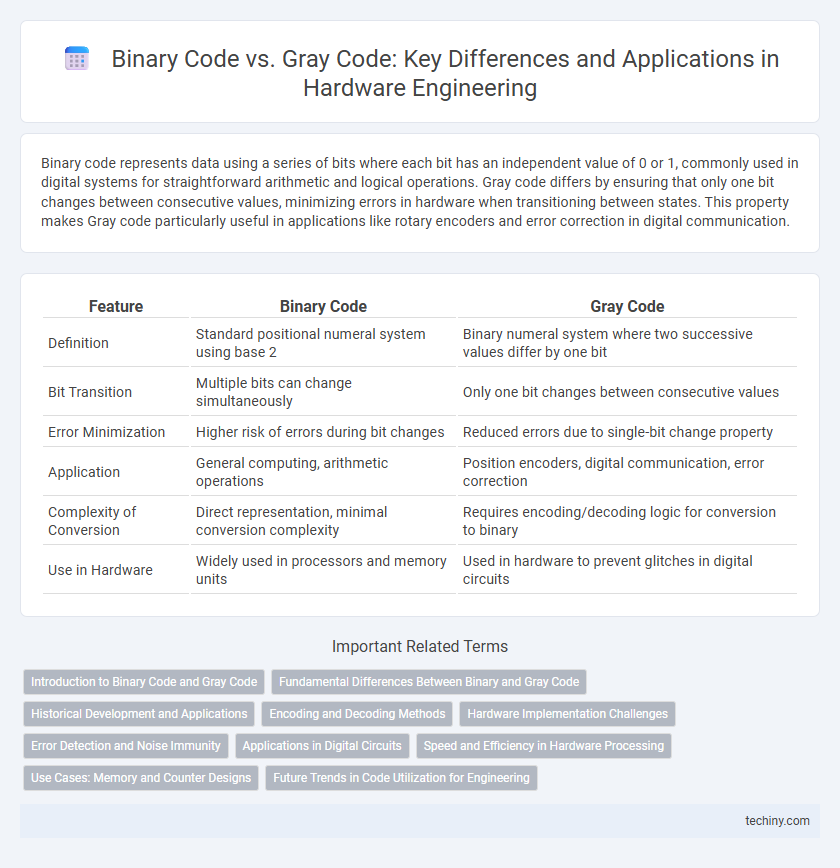Binary code represents data using a series of bits where each bit has an independent value of 0 or 1, commonly used in digital systems for straightforward arithmetic and logical operations. Gray code differs by ensuring that only one bit changes between consecutive values, minimizing errors in hardware when transitioning between states. This property makes Gray code particularly useful in applications like rotary encoders and error correction in digital communication.
Table of Comparison
| Feature | Binary Code | Gray Code |
|---|---|---|
| Definition | Standard positional numeral system using base 2 | Binary numeral system where two successive values differ by one bit |
| Bit Transition | Multiple bits can change simultaneously | Only one bit changes between consecutive values |
| Error Minimization | Higher risk of errors during bit changes | Reduced errors due to single-bit change property |
| Application | General computing, arithmetic operations | Position encoders, digital communication, error correction |
| Complexity of Conversion | Direct representation, minimal conversion complexity | Requires encoding/decoding logic for conversion to binary |
| Use in Hardware | Widely used in processors and memory units | Used in hardware to prevent glitches in digital circuits |
Introduction to Binary Code and Gray Code
Binary code represents data using two distinct states, 0 and 1, making it fundamental for digital circuits and computing systems. Gray code, also known as reflected binary code, differs by changing only one bit between consecutive values, reducing errors in hardware such as rotary encoders and analog-to-digital converters. Both coding schemes are crucial in hardware engineering, with binary code optimizing straightforward data representation and Gray code enhancing error minimization in sequential data transitions.
Fundamental Differences Between Binary and Gray Code
Binary code represents values using a base-2 numeral system where each bit reflects an increasing power of two, enabling straightforward arithmetic operations and digital circuit implementation. Gray code differs by ensuring that only one bit changes between successive values, minimizing errors during state transitions in hardware such as encoders and analog-to-digital converters. This fundamental difference makes Gray code particularly advantageous for reducing glitches in digital systems where precise signal transitions are critical.
Historical Development and Applications
Binary code, developed in the early 20th century, became the foundation of digital computing due to its straightforward representation of data using two distinct states. Gray code, introduced by Frank Gray in the 1930s, was designed to minimize errors in analog-to-digital conversions by ensuring only one bit changes at a time between consecutive values. Binary code remains prevalent in general computing and data storage, while Gray code is specifically applied in rotary encoders, error correction, and Karnaugh maps for simplifying Boolean expressions.
Encoding and Decoding Methods
Binary code encoding converts data directly into a base-2 numeral system where each bit position represents an increasing power of two, allowing straightforward arithmetic operations and digital circuit implementation. Gray code encoding ensures only one bit changes between successive values, reducing errors in digital systems by minimizing signal transitions during state changes. Decoding binary code involves direct bit value interpretation, while Gray code decoding requires bitwise XOR operations to retrieve the original binary number, enhancing reliability in hardware error detection and correction.
Hardware Implementation Challenges
Binary code simplifies hardware implementation with straightforward combinational logic and minimal error correction circuitry. Gray code, while reducing errors during state transitions, requires complex encoding and decoding circuits that increase gate count and latency. Designing hardware for Gray code demands careful optimization to balance error mitigation against increased resource utilization and timing constraints.
Error Detection and Noise Immunity
Binary code is widely used in hardware engineering for data representation but is more susceptible to errors during signal transitions due to multiple bit changes between consecutive values. Gray code improves noise immunity and error detection by ensuring only one bit changes at a time between successive values, minimizing the likelihood of transient errors in digital circuits. This characteristic makes Gray code essential in applications like rotary encoders and analog-to-digital converters where precise error minimization is critical.
Applications in Digital Circuits
Binary code is widely used in digital circuits for straightforward data representation and arithmetic operations, enabling efficient processing and storage in microprocessors and memory systems. Gray code minimizes errors during state transitions by ensuring only one bit changes at a time, which is critical in rotary encoders, error correction in analog-to-digital converters, and position sensors. Implementing Gray code in digital circuits enhances reliability and accuracy in applications requiring precise and noise-immune signal interpretation.
Speed and Efficiency in Hardware Processing
Gray code reduces errors in hardware processing by ensuring only one bit changes at a time, minimizing transition delays compared to binary code. This transition efficiency accelerates data handling in digital circuits, particularly in counters and encoders, where rapid and reliable state changes are critical. Hardware systems leveraging Gray code achieve higher speed and energy efficiency, enhancing overall processing performance.
Use Cases: Memory and Counter Designs
Binary code is widely used in memory addressing and arithmetic operations due to its straightforward implementation and compatibility with digital circuits. Gray code is preferred in counter designs and error correction systems because it minimizes errors by changing only one bit between successive values, reducing signal glitches. Memory architecture benefits from binary code's simplicity, while Gray code enhances accuracy and reliability in mechanical encoders and asynchronous counters.
Future Trends in Code Utilization for Engineering
Future trends in hardware engineering indicate increasing adoption of Gray code over binary code due to its error-reduction capabilities in digital communication and rotational encoders. Emerging applications in quantum computing and high-speed data transmission prioritize Gray code for minimizing transition errors and power consumption. Advanced sensor technologies and error-correcting circuits are expected to leverage Gray code's robustness, shaping the evolution of code utilization in next-generation hardware systems.
Binary code vs Gray code Infographic

 techiny.com
techiny.com